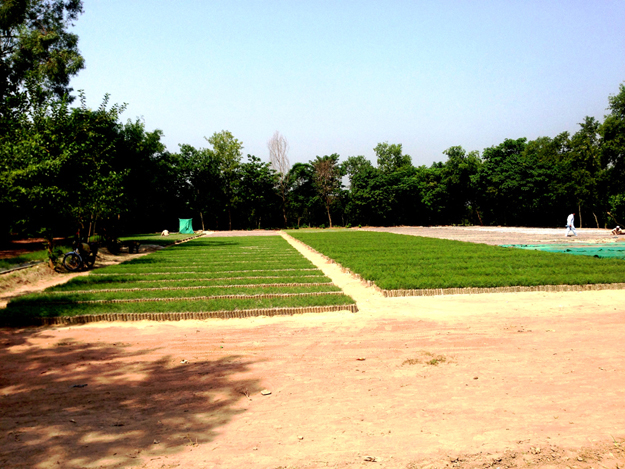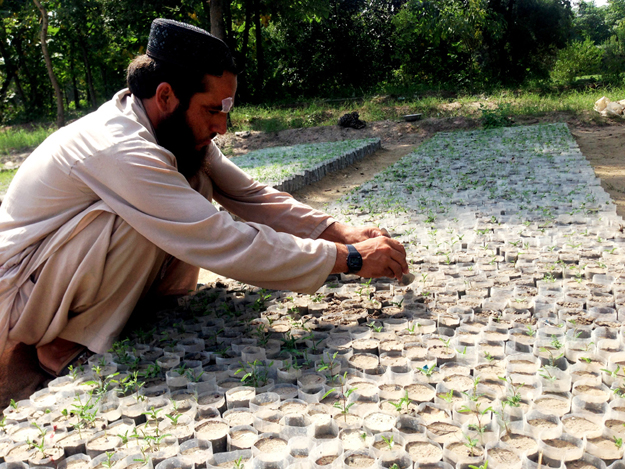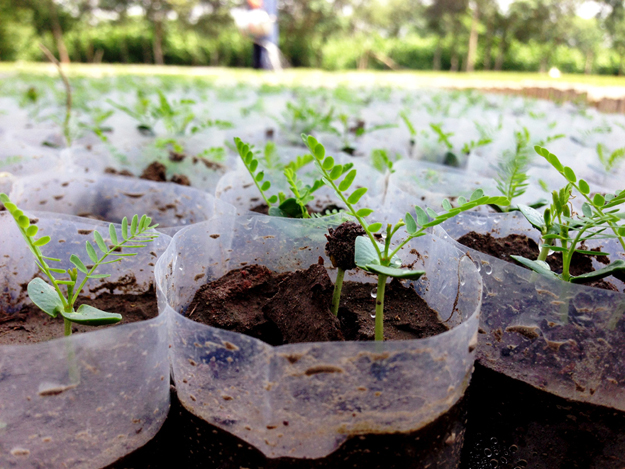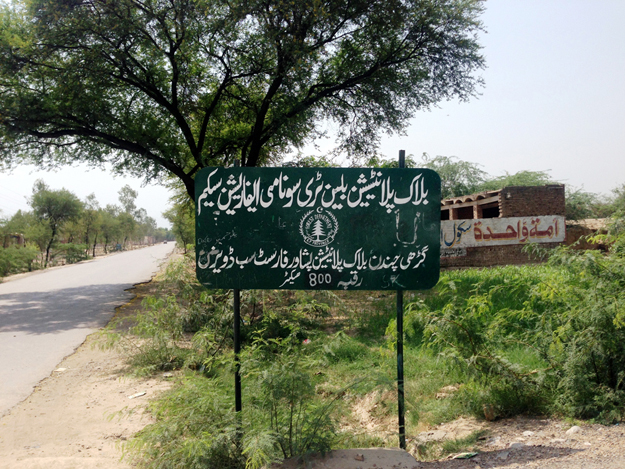
“We water plants after every 10 days or on the day when the temperature is high,” he said while fetching water for plants.
Garhi Chandan area was a barren terrain situated at a distance of around 25 kilometres from Peshawar. The region bordering tribal areas of FR Peshawar was once a bastion of miscreants and had been declared a red zone.
Locals used to witness criminal and terror activities on a regular basis, but were not able to control it. One of the locals, who requested not to be named, told The Express Tribune that high-profile terrorists residing in Garhi Chandan used to plan terror activities and even slaughtered people.

Green day: Imran Khan inaugurates ‘Billion Tree Tsunami’
“Now that the region has been nearly cleansed of terrorists and one million saplings have been planted under the Billion Tree Tsunami Forestation project, the land has become of immense importance not only for the local population, but also for the entire world,” he added.
Much has been reported in the media, which is confined only to documents and interviews. The most recent report by the International Union for Conservation of Nature (ICUN) praised the Khyber-Pakhtunkhwa (K-P) government for surpassing the Bonn Challenge of reclaiming more than 348,000 hectares of barren and degraded land.
A team of The Express Tribune visited the site to witness the saplings being planted in the region to check if the claims of the K-P government were true.
Entering the plantation range spread over 800 hectares or 16,000 kanals, a nursery has been set up where more than 800,000 seeds have been sown, which will have to be shifted to the plantation region to cross the target of one billion.
Billion Tree Tsunami Over 3 million saplings planted in Gallies
The IUCN report claims that more than 13,000 private tree nurseries have been established under the project across the province which has already boosted local income, generated thousands of green jobs and empowered unemployed youth as well as women in the province.

Having hilly terrains on both sides, the unpaved road that enters into the site was entirely barren before the forestation. “There wasn’t any plant in the land except for those that had grown naturally,” Muhammad Saleem, a local resident, told The Express Tribune.
The villages are far away from the plantation site since the land was barren and owned collectively by the people of the village.
Saleem said now since the plants have grown, the villagers are taking keen interest in protecting them.
The project has been executed in all the K-P districts on divisional basis. The team has checked Garhi Chandan, which is the major site of Peshawar division. The saplings consist of species of shesham, polai, chirpine, kikar, zizyphus, sanata, willow, poplar, amaltas, cypress, Eucalyptus and bakain and are planted 10 feet away from each other in squares.
'Billion tree tsunami' surges across K-P
“More than 4.5 million saplings have been planted in Peshawar division consisting of regions of Army Range-1 and 2, Mistri Banda, Manki Sharif, Bela Mohmandan, Azakhel, Katozai, Kheshgi, Torlandi areas of Nowshera, Charsadda, and Peshawar with reclamation of over 4,000 hectares of land,” said Shafqat Munir, Forest Department Chief Conservator Central and Southern region of the project.
Munir told The Express Tribune that the government had estimated to spend a total of Rs22 billion on the project when it was launched in January 2015. “Till now, over Rs10.5 billion has been utilised and it is expected that the target of one billion trees will be completed at a total cost of Rs14 billion.”
Eighty per cent of the funds, Munir said, have been utilised to employ, on temporary basis, some 500,000 people living below the poverty line for the project. He said the government would complete the target of one billion trees by August 31 and an event would be arranged in Islamabad to celebrate the achievement.

Watering mechanism
Water reservoirs have been constructed after every 10 hectares of land where saplings are planted. The team witnessed workers watering plants through plastic pipes connected to reservoirs where water was pumped up to the hilly terrain through motors running on generators using petrol.
K-P surpasses international target of planting trees
When asked about the water, Divisional Forest Officer (DFO) Gulzar Khan said the water reservoirs are filled 24 hours either from rain water or from the springs connected to it.
Khan said workers have been employed on daily wages since the initiation of the project. They are receiving a wage of Rs500 per labourer. “The saplings are watered according to their maturity level.”
Furthermore, he said a normal plant needs to be watered around 15 times in a year to keep it healthy and green, depending upon its growth. He said more than 300 locals have been employed as watchmen and gardeners.
In some places, the plants were witnessed to be watered manually through buckets by the labourers, mostly by residents of the region.
What’s left?
Providing details of progress, Conservator Munir said that only 30 million to 40 million plants are left to be planted to achieve the goal of one billion. Seeds have been sown on more than 5.3% of the total 2.5 million hectares of barren land in the province.
Embezzlement in Billion Tree Tsunami: Former anti-graft body director’s claims denied
Currently, 22% of the land is covered by forests, while after the completion of the project over 25% of the land of the province will be covered by trees.

About the Bonn Challenge – forestation on 348,000 hectares of land – Munir said “We have planted trees over 618,000 hectares, which is double the challenge.”
He said to achieve the target of one billion trees, 40% were regenerated naturally, 20% through farm forestry and 40% through plantations. “The 40% regeneration also occurs owing to plantation activities in the vicinity of the land,” he added.
When asked about criticism by some ecologists on planting Eucalyptus, Munir said some experts and international organisations were indulged in illogical arguments that this species of plants harmed the water table of the ground.
He said less than 10% of the total saplings are Eucalyptus planted under the project, which give oxygen, take carbon and provide timber like the rest of the plants. “I wonder why this plant is the hated one among the ecologists across the globe.”
Revenue generation
Speaking about revenue generation from the project, Munir briefed that around Rs50 is spent on a single tree plantation if all expenses are added. On maturity, it would be Rs1,000 per tree, he said.
“Both the locals and the government will benefit from the project when the plants reach maturity level,” he said, adding that the plants would be handed over to the community after June 2018.
A mechanism has been set up for generating revenue from trees by the forest department. The community will pay Rs500 per trolley of timber, depending upon the type of tree they are supplying to the rest of the country, which will generate billions of rupees revenue after seven years when the plants mature.
About intangible benefits, he said it would help in controlling the earth’s atmosphere to combat climate change. Furthermore, he said it would protect many areas from floods like the hilly areas of Chitral.
When asked about identifying the site for plantation, he said the departments take three things into account before selecting the site for plantation.
Availability of roads is the first thing to be kept in mind, he said. Secondly, he informed, it has been to be seen if the land was barren or not agricultural. Third comes the availability of water for the plants, he added.
Importantly, Munir said that since the area had been the bastion of terrorism for quite some time, the plantations project has helped in keeping the locals away from illegal activities.
Monitoring the project
Other than the forest department’s monitoring teams, the project is also monitored by a third party, World Wildlife Fund (WWF). So far, two monitoring reports have been released by the fund.
According to a report released in 2016, a copy of which is available with The Express Tribune, the survival rate of the plants sown was more than 70% in most parts of the sites.
However, the report suggested not to use pesticides as it was used in Kohat to protect the plants from external attack.
Munir admitted that pesticide was used as the plants were damaged by termites, but its effect would vanish within a year and in the future it wouldn’t be used as per the recommendations of the WWF.
1726054615-0/OpenAI-(2)1726054615-0-270x192.webp)











COMMENTS
Comments are moderated and generally will be posted if they are on-topic and not abusive.
For more information, please see our Comments FAQ